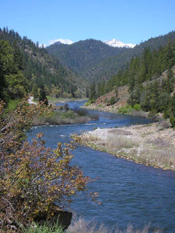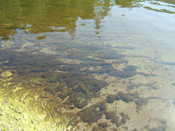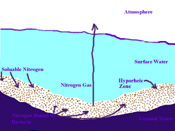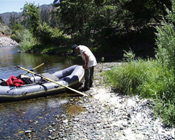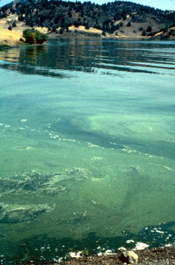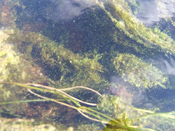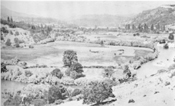Free-flowing River vs. Lake
- Healthy, free-flowing river reaches trap and remove nutrients through:
- 1) assimilation by rooted aquatic plants (macrophytes) and attached algae, and
- 2) denitrification below the stream bed in the ground water-surface water interface.
- Daily flow fluctuations in the Klamath Hydroelectric Project's (KHP) J.C. Boyle hydropower peaking reach reduce nutrient retention by inhibiting the growth of attached algae and macrophytes.
- Bypass flows to KHP powerhouses do not contribute to nutrient retention, and impair decomposition of organic matter.
High levels of nutrients (nitrogen and phosphorus) in the Klamath River cause excessive growths of algae, resulting in degraded water quality conditions like pH and dissolved oxygen levels that are stressful to fish. Natural processes like denitrification, organic matter burial in bottom sediments, sediment sorption, and plant (algae and macrophytes) and microbial uptake can remove nitrogen from rivers, resulting in improved downstream water quality (Seitzinger et al, 2002). Klamath-specific studies have not yet conclusively determined the relative contributions of the various natural nitrogen retention processes, but likely candidates include:
1. Assimilation by rooted aquatic plants (macrophytes) and attached algae
2. Denitrification in the ground water-surface water interface (hyporheic zone)
In a free-flowing river, benthic (bottom) algae can efficiently collect nutrients and assimilate them into biomass, which can bring down dissolved nutrient levels. Triska et al. (1984) found that nitrogen entering a small Cascade stream was reduced 34% by biological and hydrologic processes in their study reach. Tanner and Anderson (1996) found that over a 60-mile study reach on the South Fork Umpqua River in Oregon, periphyton assimilated about 90% of the dissolved inorganic nitrogen load discharged into the river from wastewater treatment plants. A recent major nationwide study confirmed that denitrication is an imporant nitrogen sink in rivers and streams (Mulholland 2008).
In addition to being caught and bound up by benthic algae, nitrogen may also be reduced as surface water is mixed with subsurface flow in the hyporheic zone (at right). According to Naiman and Bilby (1998), the hyporheic zone is the "saturated sediment beneath and beside streams and rivers where surface and ground waters meet.....Rivers with extensive hyporheic zones retain and process nutrients with greater efficiency than rivers without." They note that "organic matter elimination can be two times greater in rivers with intact hyporheic zones." As surface water enters the hyporheic zone it comes in contact with bacteria which bind nitrogen and create anaerobic conditions. As the water travels a greater distance underground, oxygen depletion occurs and nitrogen may be converted to its gaseous form and escape to the atmosphere (at right).
The amount of nitrogen removed from some rivers by hyporheic denitrification can be substantial. For example, during midsummer in Colorado’s South Platte River hyporheic denitrification resulted in a 90% reduction of nitrate in one 6 km long reach (Sjodin et al. 1997). The Klamath Hydroelectric Project dams have submerged significant portions of the river, decreasing its hyporheic function.
In the reaches below J.C. Boyle and Copco 2 dams, the Project diverts the majority of the flow from the river and it runs for several miles in ditches and flumes. The diverted water keeps its nutrient load because it does not come in contact with benthic algae or a hyporheic zone. In addition, the diverted water avoids a turbulent journey down the river that would help break down organic matter and phytoplankton (Karuk Tribe, 2006). Nutrient removal by natural river functions are arrested through these Project diversions.
The benthic algae community thrives during low water periods, when a lack of stream scour allows them to establish (Naiman and Bilby, 1998). The PacifiCorp Project creates substantial fluctuations in flow in order to peak its power production during summer months. As the river fluctuates from 350 cubic feet per second (cfs) to 1500 or even 3000 cfs and back each day, algae is scoured during these high flows, then dries up during low flows. In the portions of the Klamath River not subject to hydropower peaking, channel margins are the favored habitats for benthic algae as since shallow water provides ample sunlight and low water velocities do not scour the substrate. The channel margins are most effected by hydropower peaking. Therefore, as PacifiCorp (2005) itself has acknowledged, benthic algae production in reaches that are effected by peaking decreases as does the over-all nutrient stripping capability of the river.
Nitrogen fixing "is an important external input of nitrogen accumulation in water bodies and can materially affect nitrogen dynamics" (Deas and Orlob, 1999). The reservoirs in the Project are downstream of Upper Klamath Lake and vast agricultural tracts, which both produce nutrients (see Location). Summer blue green algae (A. flos-aquae) blooms in each Project reservoir add or fix nitrogen. In this way, the Project changes natural biological functions and nitrogen cycling dramatically by flooding reaches of the Klamath River. See Water Quality for more details on reservoir nutrient dynamics.
Mass-balance nutrient budgets were constructed and summarized on seasonal time scales (June 1 - October 20 and July 1 - September 30) to assess temporal nutrient dynamics and the relative fate of nutrients in five free-flowing reaches of the Klamath River for 2005-2008 (Asarian et al. 2010). These analyses indicate that large quantities of nitrogen and phosphorus are retained when longer river lengths were considered. For example, the Iron Gate nutrient load was reduced by 24% for total phosphorus (TP), 25% for soluble reactive phosphorus (SRP), 21% for particulate phosphorus (PP), 41% for total nitrogen (TN), 93% for total inorganic nitrogen (TIN), and 21% for organic nitrogen (ON) during July- September 2007-2008 in the 130 miles from Iron Gate to Orleans.
To provide a range of estimates for how TP and TN concentrations at Iron Gate Dam might change under a dam removal scenario, relative retention rates in river reaches were compared with results from a study of the Copco-Iron Gate Reservoir complex by Asarian et al. (2009). The results of this analysis (Asarian et al. 2010) indicate that dam removal will result in only a very small increase in TP concentration in the Klamath River between Iron Gate and Turwar. TN concentrations will increase more than for TP, although the magnitude of the increase diminishes with increasing distance downstream of Iron Gate. The effect is substantially diminished by Orleans and quite small at Turwar. Although estimated nutrient concentrations are predicted to increase in the mainstem Klamath River downstream of the dams following dam removal, the resulting effects on algal and macrophyte growth are complex and may vary by reach.
References
Asarian, E. J. Kann, and W. Walker. 2010. River Nutrient Loading and Retention Dynamics in Free-Flowing Reaches, 2005-2008. Final Technical Report to the Yurok Tribe Environmental Program, Klamath, CA. 59pp + appendices.
Asarian, E. J. Kann, and W. Walker. 2009. Multi-year Nutrient Budget Dynamics for Iron Gate and Copco Reservoirs, California. Prepared by Riverbend Sciences, Kier Associates, Aquatic Ecosystem Sciences, and William Walker for the Karuk Tribe Department of Natural Resources, Orleans, CA. 55pp + appendices.
Asarian, E. and J. Kann. 2006. Klamath River Nitrogen Loading and Retention Dynamics, 1996-2004. Kier Associates Final Technical Report to the Yurok Tribe Environmental Program, Klamath, California. 56pp + appendices.
Boyle, J.C. 1976. 50 years on the Klamath. Medford, Oregon, Klocker Printery, 59 pp.
Deas, M. L. and G. T. Orlob. 1999. Klamath River Modeling Project. Project #96-HP-01. Assessment of alternatives for flow and water quality control in the Klamath River below Iron Gate Dam. University of California Davis Center for Environmental and Water Resources Engineering. Report No. 99-04. 379 pp. [3.6 Mb]. At KRIS Web site
Karuk Tribe of California. 2006. Comments on Draft EIS in Klamath Hydroelectric Project Docket for Filing: P-2082-027 (Klamath). Submitted to FERC by the Karuk Tribe of California, Orleans, CA. 60 pp.
Kann, J. and E. Asarian. 2007. Nutrient Budgets and Phytoplankton Trends in Iron Gate and Copco Reservoirs, California, May 2005 - May 2006. Final Technical Report to the State Water Resources Control Board, Sacramento, California. 81pp + appendices.
Mulholland, A.M. Helton, G.C. Poole, R.O. Hall, S.K. Hamilton, B.J. Peterson, J.L. Tank, L.R. Ashkenas, L.W. Cooper, C.N. Dahm, W.K. Dodds, S.E.G. Findlay, S.V. Gregory, N.B. Grimm, S.L. Johnson, W.H. McDowell, J.L. Meyer, H.M. Valett, J.R. Webster, C.P. Arango, J.J. Beaulieu, M.J. Bernot, A.J. Burgin, C.L. Crenshaw, L.T. Johnson, B.R. Niederlehner, J.M. O'Brien, J.D. Potter, R.W. Sheibley, D.J. Sobota & S.M. Thomas. 2008. Stream denitrification across biomes and its response to anthropogenic nitrate loading. Nature. 452 (7184): 202-204.
Naiman, R.J. and R.E. Bilby. 1998. River Ecology and Management: Lessons from the Pacific Coastal Ecoregion. Springer Press, New York, N.Y. 705 p.
PacifiCorp, 2005. Response to FERC AIR GN-2, Status Report, Klamath River Water Quality Modeling, Klamath Hydroelectric Project Study 1.3 (FERC Project No. 2082). PacifiCorp: Portland, Oregon. 131 pp.
Triska, F.J., J.R. Sedell, K.Cromack, Jr., S.V. Gregory and F.M. McCorison. 1984. Nitrogen Budget of a Small Coniferous Forest Stream. Ecological Monographs. 54:119-140.
Seitzinger, S.P., R.V. Styles, E.W.Boyer, R.B. Alexander, G.Billen, R. Howarth, B. Mayer and N. van Breemen. 2002. Nitrogen retention in rivers: model development and application to watersheds in the northeastern U.S.A Biogeochemistry 57/58: 199-237.
Sjodin, A.L., W.M. Lewis Jr., and J.F. Saunders III. 1997. Denitrification as a component of the nitrogen budget for a large plains river. Biogeochemistry 39: 327-342.
Tanner D.Q. And C.W. Anderson. 1996. Assessment of Water Quality, Nutrients, Algal Productivity, and Management Alternatives for Low-Flow Conditions, South Umpqua River Basin, Oregon, 1990-92. U.S. Geological Survey, Water-Resources Investigations Report 96-4082. See: http://or.water.usgs.gov/pubs_dir/Pdf/96-4082.pdf

